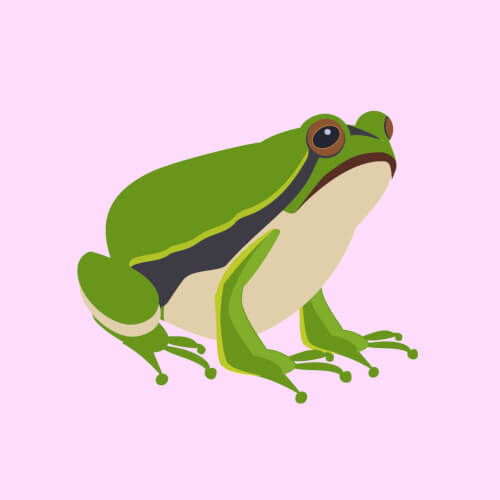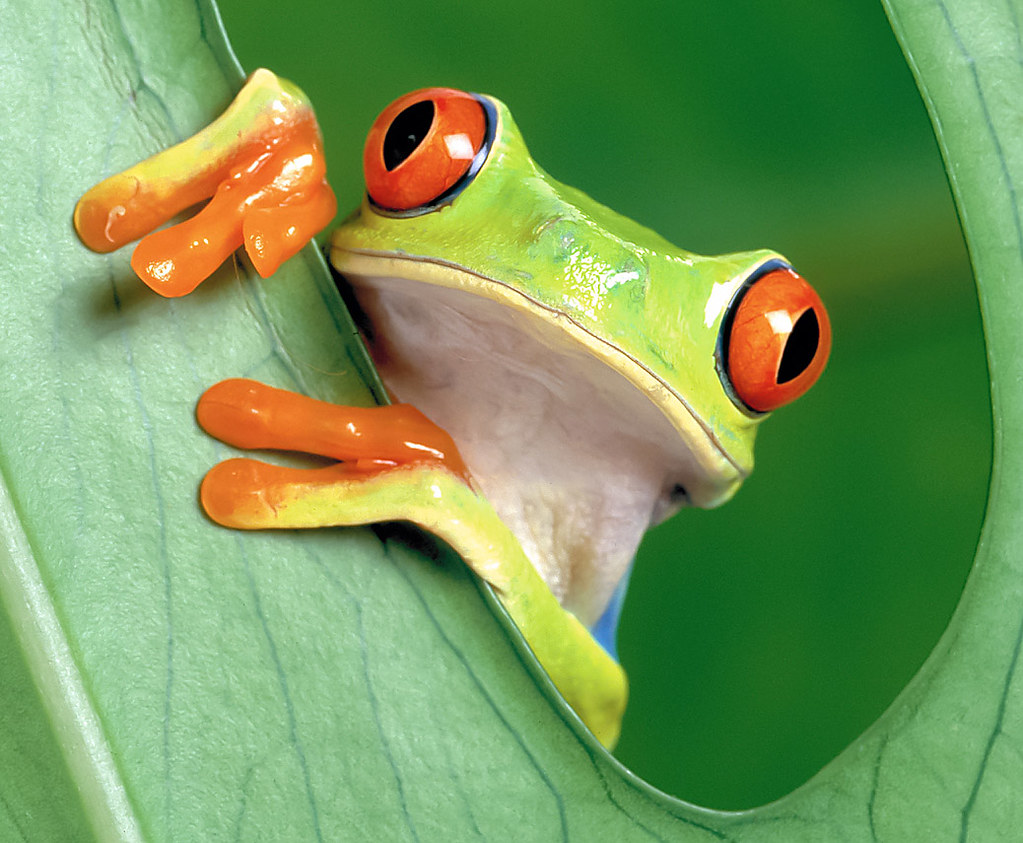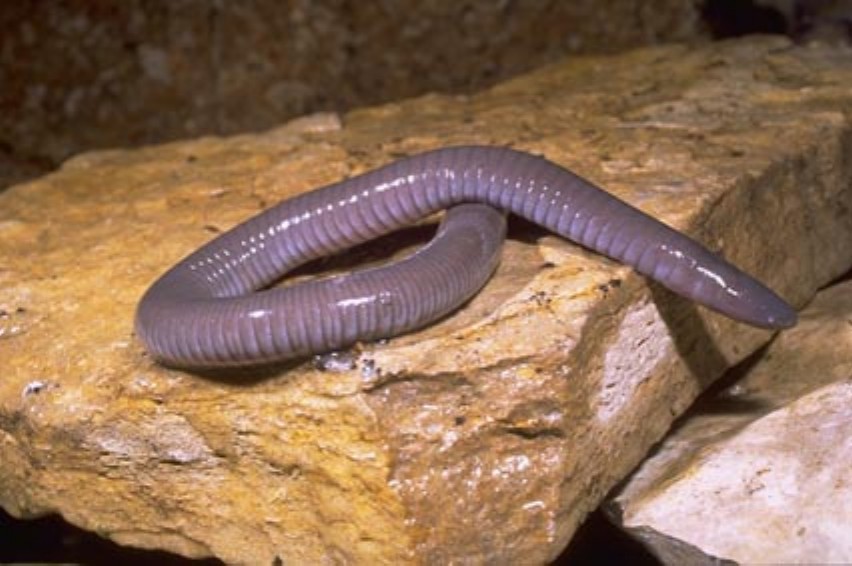


An amphibian is a small, cold-blooded vertebrate that hatches in water with gills, but later grows lungs and can breathe air. Scientists split the over 6,000 species of amphibians into three main groups: Anura (frogs and toads), Urodela (salamanders), and Apoda (caecilians).
| Taxonomic Rank | Name | Common Name |
|---|---|---|
| Kingdom | Animalia | Animals |
| Phylum | Chordata | Vertebrates |
| Class | Amphibia | Amphibians |

Frogs and toads are members of the taxonomic order Anura, which means "without tail" in Ancient Greek. While we often use the term "toad" to describe wartier-looking frogs, there is no formal difference between the two. Scientists estimate that the first frog-like amphibian appeared during the Permian period about 265 million years ago [1].
Frogs are known for their short, tailless bodies, and carnivorous diets. They can be found in various climates ranging from the tropics to subarctic regions, with the largest diversity of species living in tropical rainforests. In fact, about 88% of all frog species, more than 6,300 species, are found in tropical rainforests [1].
While we often associate frogs with green or brown colors, they actually come in many different colors and patterns. Some frogs are brightly colored as a warning to predators that they are toxic, while others use camouflage to blend in with their environment [2].
Toads, on the other hand, are typically characterized by their warty skin and plump bodies. Contrary to popular belief, toads do not cause warts. Instead, those bumps on their skin help protect them from predators. Some species of toads also have paratoid glands, which can secrete toxins as a defense mechanism [2].

All salamanders are grouped under the taxonomic order Urodela. Salamanders are lizard-like in appearance, with skinny bodies; short, blunt snouts; short limbs; and tails both as efts (the equivalent of a tadpole) and as adults. A salamander's legs stick out straight from its body and typically have at most four toes on their front legs and five on their back legs [3]. They are one of the few species capable of regenerating lost limbs and can even regrow other body parts [4].
Most salamander species are found in the Northern Hemisphere [5]. Because of their moist, permeable skin, salamanders are reliant on habitats in cool, damp areas, typically including places in or near water. Just like frogs, salamanders are also carnivorous [6].

Caecilians (pronounced seh-SILL-yens, literally meaning "blind ones" in Latin—and definitely not to be confused with Sicilians!) might just be a group of amphibians that you've never heard of before. Caecilians are characterized as being legless and snake-like with long, skinny, and smooth bodies and belong to the taxonomic order Apoda [7]. Some species of caecilian can grow up to 1.5 m in length, with some smaller species being small enough to resemble worms [8].
Caecilian species mostly live underground or in the muddy ground near and around bodies of water. Most caecilian species are found in the tropics in South America, Central America, Africa, and southern Asia. Caecilians are also carnivorous and eat a diet of other underground-living animals such as earthworms [8].
| Language | Sounds Like... |
|---|---|
| Chinese | Guo-guo |
| English | Ribbit |
| German | Kwaak |
| Hungarian | Brekeke |
| Italian | Cra-cra |
| Language | Sounds Like... |
|---|---|
| Japanese | Kero-kero |
| Korean | Gae-gool |
| Polish | Kum-kum |
| Thai | Op-op |
| Turkish | Vrak |
Although frogs' tongues aren't quite as long as they are in cartoons (stretching for meters at a time), frogs still have tongues that measure about a third of their body length—usually a few centimeters.
Frogs' tongues are attached at the front of their mouths, rather than the back. This allows the amphibians to extend their tongues much further and catch their meals. Additionally, a frog's tongue isn't sticky all the time—otherwise, it would glue its mouth shut! Instead, frogs produce sticky mucus right before attempting to catch their prey.
Unlike other animals that drink water through their mouths, amphibians actually absorb water through their skin. Specifically, they have a specialized area of skin on their belly and under their thighs called the ventral patch. This area is highly permeable and allows water to enter their body.
This ability to absorb water through their skin is especially important for amphibians that live in dry environments or during times of drought when water sources may be scarce. For example, desert-dwelling amphibians such as the spadefoot toad rely heavily on their ability to absorb water through their skin to survive in their arid habitats. However, it is important to note that not all amphibians rely solely on skin absorption for their water needs. Some species, such as the axolotl, also drink water through their mouths.
While most animals breathe using lungs, frogs are able to absorb oxygen through their skin as well. This is especially important for frogs that live in water, as they can absorb oxygen from the water around them using their skin.
In addition to absorbing oxygen through their skin, frogs also breathe using their lungs; however, the amount of oxygen they get through their skin is actually more efficient than the amount they get through their lungs! This is because their skin has a large surface area that allows for more oxygen to be absorbed.
Frogs have large, bulging eyes that are positioned on the top of their heads, which allows them to have a near-panoramic view of their surroundings. Additionally, the position of their eyes allows them to see potential predators from many angles, making it easier for them to escape danger. Some species of frogs also have the ability to retract their eyes into their skulls for added protection. This unique adaptation is important for their survival in their natural habitats, where they must constantly be on the lookout for danger.
[1] Zheng, Y., Wiens, J. J. (2016). Combining phylogenomic and supermatrix approaches, and a time-calibrated phylogeny for squamate reptiles (lizards and snakes) based on 52 genes and 4162 species. Molecular Phylogenetics and Evolution, 94, 537-547.
[2] Ellinwood, J. R. (2008). Biology of the amphibians. In Reptile Medicine and Surgery (2nd ed.), pp. 336-356. Saunders Elsevier.
[3] Petranka, J. W. (1998). Salamanders of the United States and Canada. Smithsonian Institution Press.
[4] Bryant, H. N. (1940). The Regeneration of Body Parts: Annotated Bibliography 1901-1927. The Quarterly Review of Biology.
[5] Wake, D. B., Vredenburg, V. T. (2008). Are We in the Midst of the Sixth Mass Extinction? A View from the World of Amphibians. Proceedings of the National Academy of Sciences of the United States of America.
[6] Anderson, J. D., Guttmann, S. I. (1973). Feeding Behavior of Larval and Juvenile Salamanders. The American Midland Naturalist.
[7] Wilkinson, Mark, et al. "Evolutionary relationships of the blind snakes (Serpentes: Scolecophidia: Typhlopoidea) based on mitochondrial and nuclear genes." Molecular Phylogenetics and Evolution 56.1 (2010): 380-388.
[8] "Caecilian." Encyclopædia Britannica. Encyclopædia Britannica, Inc., n.d. Web. 31 Mar. 2023.
[9] Deban, S. M., & O'Reilly, J. C. (2005). The evolution of feeding motor patterns in amphibians. In R. L. Roeder & G. G. Gans (Eds.), Biology of Amphibians (pp. 207-249). CRC Press.